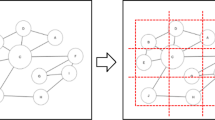Abstract
The force-directed graph layout algorithm is one of the most widely used algorithms for drawing graphs. It aims at improving the graphs’ readability and understanding by producing high-quality drawings. However, the traditional algorithm, while trying to find the most stable position for each vertex, fails to produce graphs that satisfy different aesthetic criteria. In this paper, we present an algorithm that concerns the number of edge crossings, angular resolution and crossing angles. These aesthetic criteria are chosen because they are closely related to human comprehension. In addition, we also introduce a refinement process by applying a curved edges drawing method to further improve the angular resolution, which can also beautify the final drawing. The experimental results have shown that our approach can produce graphs in a more aesthetically pleasing way with larger angular resolution, proper crossing angles and less edge crossings.









Similar content being viewed by others
References
Bannister, M.J., Eppstein, D., Goodrich, M.T., Trott, L.: Force-directed graph drawing using social gravity and scaling. Graph Draw. 7704, 414–425 (2013)
Bar, M., Neta, M.: Humans prefer curved visual objects. Psychol. Sci. 17(8), 645–648 (2006)
Baur, M., Brandes, U.: Crossing reduction in circular layouts. Proc. Workshop Graph-Theor. Conc. Comput. Sci. 3353, 332–343 (2004)
Bereg, S., Rozario, T.: Angle optimization of graphs embedded in the plane. arXiv:1211.4927v2 [cs.CG] (2013)
Bertault, F.: A force-directed algorithm that preserves edge-crossing propweties. Inform. Process. Lett. 74, 7–13 (2000)
Brandes, U., Pich, C.: An experimental study on distance-based graph drawing. Graph Draw. 5417, 218–229 (2009)
Chernobelskiy, R., Cunningham, K.I., Goodrich, M.T., Kobourov, S.G., Trott, L.: Force-directed lombardi-style graph drawing. Graph Draw. 7034, 320–331 (2012)
Davidson, R., Harrel, D.: Drawing graphs nicely using simulated annealing. ACM Trans. Graphics 15(4), 301–331 (1996)
Didimo, W., Liotta, G., Romeo, S.A.: Topology-driven force-directed algorithms. Graph Draw. 6502, 165–176 (2011)
Eades, P.: A heuristic for graph drawing. Congressus Numerantium 42, 149–160 (1984)
Fruchterman, T.M.J., Reingold, E.M.: Graph drawing by force-directed placement. Softw.-Pract. Exp. 21(11), 1129–1164 (1991)
Gajer, P., Goodrich, M.T., Kobourov, S.G.: A multi-dimensional approach to force-directed layouts of large graphs. Comput. Geometry: Theory Appl. 29(1), 3–18 (2004)
Gansner, E.R., Hu, Y., North, S.: A maxent-stress model for graph layout. IEEE Trans. Vis. Comput. Graphics 19(6), 927–940 (2013)
Gansner, E.R., Koren, Y., North, S.: Graph drawing by stress majorization. Graph Draw. pp. 239–250 (2004)
Hypercube graphs. http://mathworld.wolfram.com
Hadany, R., Harel, D.: A multi-scale algorithm for drawing graphs nicely. Disc. Appl. Math. 113(1), 3–21 (2001)
Harel, D., Koren, Y.: A fast multi-scale method for drawing large graphs. J. Graph Algorithms Appl. 6(3), 179–202 (2002)
Hobbs, R., Lombardi, M.: Global Networks. Independent Curators Inc., New York (2003)
Hua, J., Huang, M.L., Huang, W., Wang, J., Nguyen, Q.V.: Force-directed graph visualization with pre-positioning: improving convergence time and quality of layout. In: International Conference on Information Visualization, pp. 124–129 (2012)
Huang, W., Hong, S.H., Eades, P.: Effects of crossing angles. In: IEEE Pacific Visualisation Symposium, pp. 41–46 (2008)
Huang, W., Hong, S.H., Eades, P., Lin, C.C.: Improving multiple aesthetics produces better graph drawings. J. Visual Lang. Comput. 24(4), 262–272 (2013)
Huang, W., Huang, M., Lin, C.C.: Aesthetic of angular resolution for node-link diagrams: Validation and algorithm. In: IEEE Symposium on Visual Languages and Human-Centric Computing (2011)
Kamada, T., Kawai, S.: An algorithm for drawing general undirected graphs. Inform. Process. Lett. 31(1), 7–15 (1989)
Kosak, C., Marks, J., Shieber, S.: Automating the layout of network diagrams with specified visual organization. IEEE Trans. Syst. Man Cybern. 24(3), 440–441 (1994)
Lin, C.C., Yen, H.C.: A new force-directed graph drawing method based on edge-edge repulsion. J. Vis. Lang. Comput. 23, 29–42 (2012)
Purchase, H., Hamer, J., Noellenburg, M., Kobourov, S.G.: On the usability of lombardi graph drawings. Graph Draw. 7704, 451–462 (2013)
Purchase, H.C.: Which aesthetic has the greatest effect on human understanding? Graph Draw. 1353, 248–261 (1997)
Purchase, H.C.: Metrics for graph drawing aesthetics. J. Vis. Lang. Comput. 13, 501–516 (2002)
Rome graphs. http://www.graphdrawing.org/data
Source code for the Kamada–Kawai algorithm. http://harambeenet.org/guess/src/guess/com/hp/hpl/guess/layout/KamadaGraphLayout.java
Tutte, W.T.: How to draw a graph. Proc. Lond. Math. 3, 743–768 (1963)
Ware, C., Purchase, H., Colpoys, L., Mcgrill, M.: Cognitive measurements of graph aesthetics. Inform. Vis. 1(2), 103–110 (2002)
Acknowledgments
This work was supported in part by the National Natural Science Foundation of China under Grant 61163059 as well as the National High Technology Research and Development Program of China under Grant 2012AA011005. The authors would like to thank the reviewers for their helpful comments and constructive suggestions.
Author information
Authors and Affiliations
Corresponding author
Additional information
Communicated by: Gabriel Wittum.
Rights and permissions
About this article
Cite this article
Dong, W., Fu, X., Xu, G. et al. An improved force-directed graph layout algorithm based on aesthetic criteria. Comput. Visual Sci. 16, 139–149 (2013). https://doi.org/10.1007/s00791-014-0228-5
Received:
Accepted:
Published:
Issue Date:
DOI: https://doi.org/10.1007/s00791-014-0228-5




